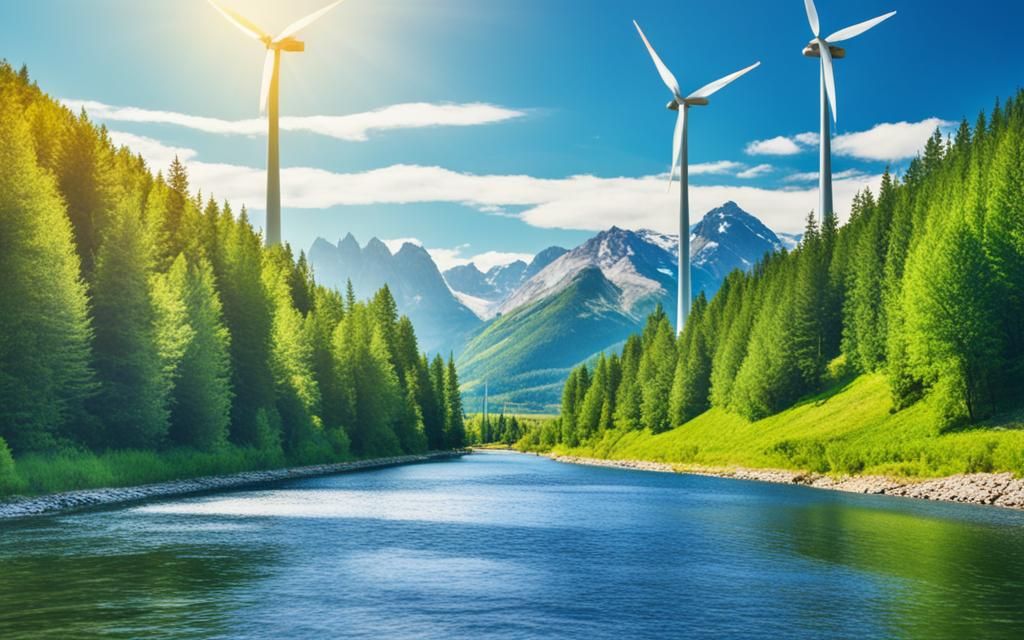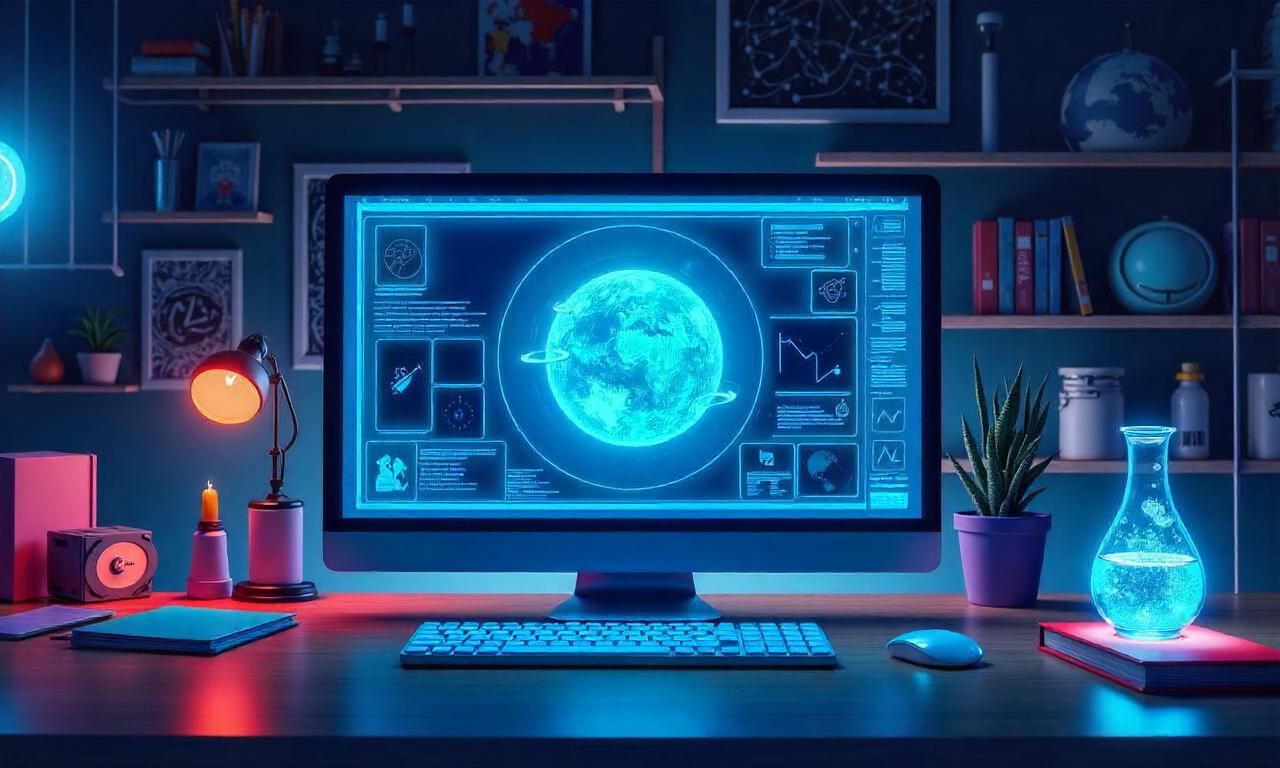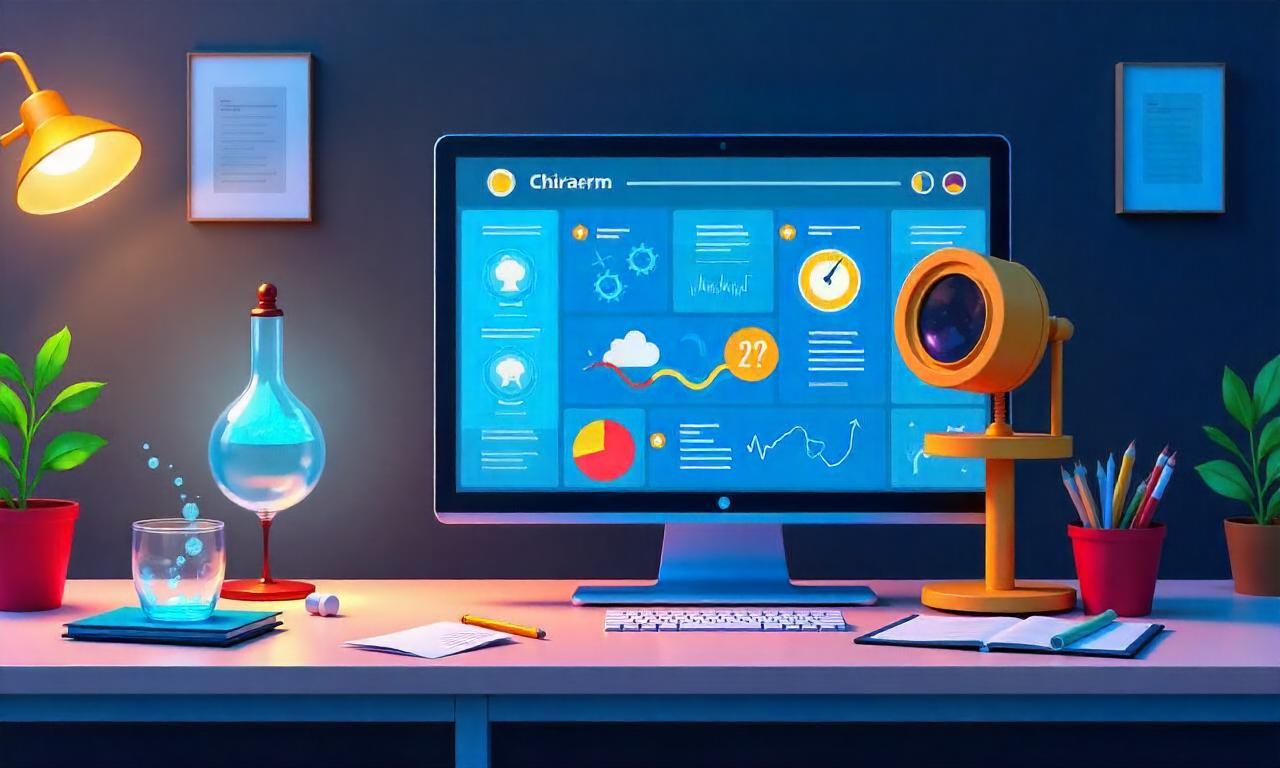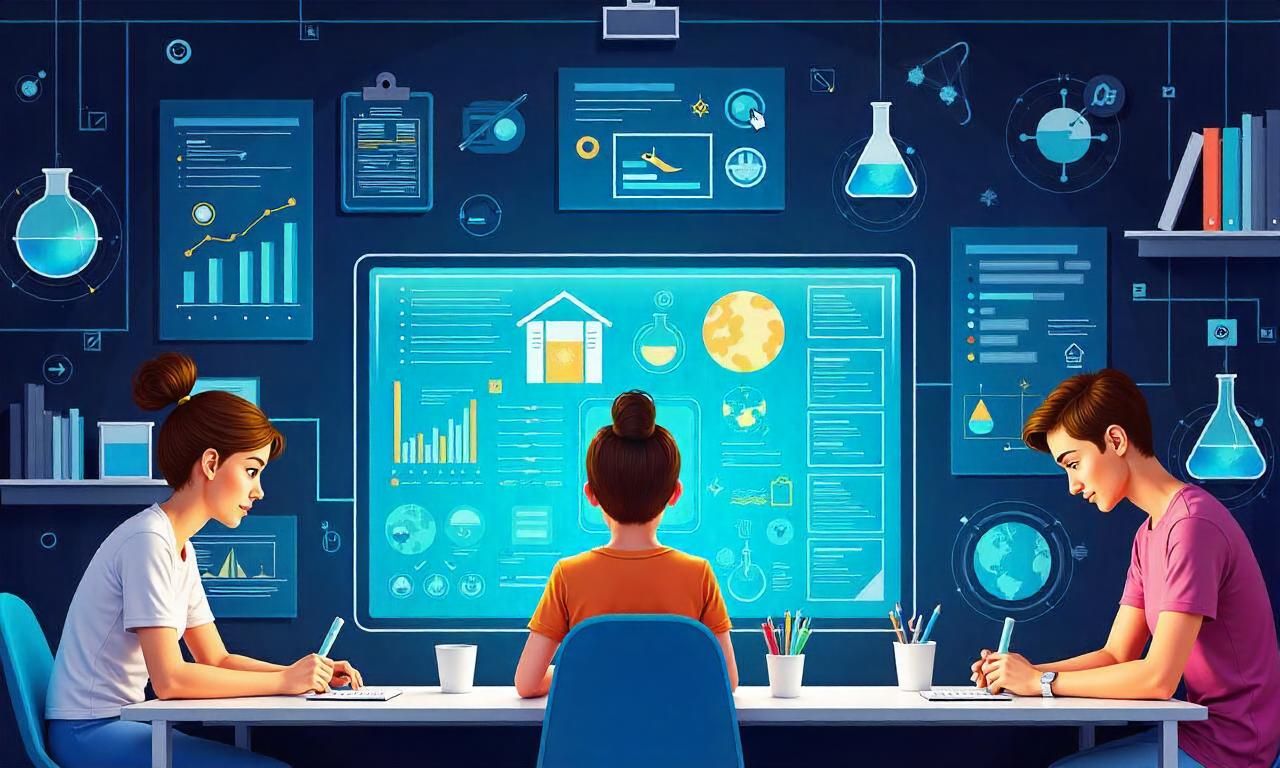The field of environmental science and technology is key to solving our planet’s challenges. This article will cover the newest trends and advancements. These changes are making our future more sustainable and eco-friendly.
Environmental science and technology bring together many fields like biology, chemistry, engineering, and policy-making. We will see how this field works to solve environmental problems and create sustainable solutions.
We’ll look at new tools for monitoring and assessing the environment. We’ll also see how waste management and recycling are changing. Plus, we’ll talk about renewable energy and how it’s changing the way we power our world.
Dealing with climate change requires new strategies and technologies. We’ll look at these efforts and how they help us make a difference. We’ll also talk about why saving nature and restoring ecosystems is so important.
Let’s start this exciting journey together. At the crossroads of environmental science and technology, we’re creating a better future. We’ll discover the latest solutions that are making our world greener.
Table of Contents
ToggleUnveiling the Significance of Environmental Science and Technology
Environmental science and technology is a key area that helps us tackle today’s environmental problems. It combines knowledge from biology, chemistry, physics, and engineering. This mix helps us understand nature and find new ways to protect the environment and be sustainable.
Understanding the Scope and Objectives
This field looks at many things, like air, water, soil, and land, and how we affect the environment. Its main goals are:
- Analyzing and monitoring environmental conditions
- Developing sustainable technologies for resource management
- Mitigating the effects of environmental pollution and degradation
- Promoting the conservation of natural habitats and biodiversity
- Fostering ecological balance and sustainable development
Exploring the Interdisciplinary Nature
Environmental science and technology’s strength comes from its interdisciplinary nature. By combining insights from different fields, we can solve environmental problems from many sides. This teamwork brings together science, technology, and policy to tackle big environmental challenges. It helps us move towards a sustainable future.
This field has the power to change how we live with nature. It balances protecting the environment, growing the economy, and improving people’s lives. As we face new environmental challenges, environmental science and technology leads the way. It shows us how to build a sustainable and resilient future.
Innovations Shaping Environmental Monitoring and Assessment
Environmental science and technology have seen big leaps forward. These changes are changing how we check and understand our environment. Now, we use remote sensing and data analytics to get detailed info on air quality, water, soil, and more. These tools help us make smart choices, plan better, and tackle environmental issues.
Remote sensing is a big deal in environmental monitoring. Satellites and sensors give us live data on many environmental factors. This lets us watch land use, track deforestation, and spot environmental dangers with great accuracy. With remote sensing, we can see the big picture of our ecosystems. This helps us manage resources and protect nature better.
Data analytics is also changing the game in environmental assessment. It uses complex algorithms and machine learning to sift through lots of data. This helps us find patterns, trends, and problems we couldn’t see before. It lets us tackle environmental issues directly and see if our solutions work. Smart technologies like internet-connected sensors and real-time systems help us collect and understand environmental data better.
Thanks to these new technologies, we’re ready to face our environmental challenges. By using the latest in environmental science and tech, we can make better choices, find effective solutions, and aim for a sustainable future for Earth.
| Technology | Application | Benefits |
|---|---|---|
| Remote Sensing | Monitoring land use changes, deforestation, and environmental threats | Provides real-time, comprehensive data for informed decision-making |
| Data Analytics | Identifying patterns, trends, and anomalies in environmental data | Enables targeted interventions and tracking the effectiveness of efforts |
| Smart Technologies | Real-time data monitoring and collection using connected sensors | Enhances our ability to gather and analyze environmental data |
Sustainable Solutions for Waste Management and Recycling
Dealing with waste management is key to protecting our planet. We’re looking at new ways to follow the circular economy. This means making sure waste is minimal and resources are used again. By using new tech, recycling more, and adopting circular economy ideas, we aim to turn waste into valuable resources. This will help us build a sustainable future.
Implementing Circular Economy Principles
The circular economy is changing how we handle waste and use resources. It’s about making products that can be reused, fixed, and recycled. This keeps materials moving and cuts down on landfill and incineration. It saves natural resources and lowers waste’s harm to the environment.
To get closer to a circular economy, we’re focusing on several areas:
- Investing in advanced recycling tech to handle more materials like plastics, metals, and textiles.
- Promoting extended producer responsibility, making companies responsible for their products’ whole life cycle.
- Supporting reuse and repair infrastructure to make products last longer.
- Teaching people why recycling matters and how a circular economy benefits everyone.
By adopting these green practices, we can make less waste, recover more resources, and move towards a circular, eco-friendly future.
| Waste Management Strategies | Benefits |
|---|---|
| Recycling and Material Recovery | Helps save natural resources, cuts energy use, and keeps waste out of landfills. |
| Circular Economy Principles | Less waste, more reuse and repair, and a greener economy. |
| Waste-to-Energy Technologies | Turns waste into energy, reducing landfill use. |
| Waste Reduction and Prevention | Less waste means less strain on waste management systems. |
Harnessing Renewable Energy Sources for a Greener Future
We’re working hard to make our future greener by using renewable energy. This means using solar, wind, hydropower, and bioenergy instead of fossil fuels. These changes help cut down on harmful emissions and make our planet healthier.
Solar power is changing the way we think about energy. Solar panels are getting better and cheaper, so more people and businesses are using them. Wind energy is also growing, with big wind farms making lots of clean electricity.
Hydropower uses the power of water to make energy. It’s a steady and green way to produce electricity. Bioenergy comes from things like plants and waste, offering another clean energy choice.
Using more renewable energy helps us reduce pollution and creates new jobs. It also helps build a stronger, greener economy. As we keep improving renewable energy, the future looks bright for a healthier world.
| Renewable Energy Source | Key Advantages | Potential Challenges |
|---|---|---|
| Solar Power |
|
|
| Wind Energy |
|
|
| Hydropower |
|
|
| Bioenergy |
|
|
We’re working together to make a greener future by using renewable energy. This effort needs everyone’s support. We’re leading the way in using renewable energy to make a better world for all.

Mitigating Climate Change: Strategies and Technologies
Environmental science and technology are key in fighting climate change. We’re using new strategies and tech to cut down on greenhouse gases. This helps lessen climate change’s effects. By using many approaches, we aim for a future that’s both strong and green.
Reducing Carbon Footprint through Innovative Approaches
Lowering our carbon footprint is a big goal in fighting climate change. We’re looking at new ways to do this:
- Carbon capture and storage (CCS) systems: These are advanced technologies that catch and store carbon dioxide emissions. This stops them from getting into the air.
- Energy efficiency solutions: We’re creating and using tech that uses less energy in homes, buildings, and industries. This cuts down on emissions.
- Sustainable transportation options: We’re pushing for electric vehicles, public transport, and other low-emission ways to travel. This lowers the carbon footprint of transport.
These strategies are helping us cut our carbon footprint. They’re part of the global effort to fight climate change.
| Strategy | Objective | Potential Impact |
|---|---|---|
| Carbon Capture and Storage | Capture and sequester greenhouse gas emissions | Significant reduction in CO2 emissions, contributing to climate change mitigation |
| Energy Efficiency Solutions | Minimize energy consumption and greenhouse gas emissions | Substantial decrease in energy-related emissions, improving environmental sustainability |
| Sustainable Transportation | Promote low-emission modes of transportation | Significant reduction in transportation-related emissions, supporting a greener future |
With these new strategies and tech, we’re making big strides against climate change. Together, we can build a sustainable and resilient future for all.
Environmental Science and Technology: Driving Force for Eco-Friendly Practices
Environmental science and technology are key to a better future. They help us live in a way that’s good for the planet. By using new tech, we can all do more to protect our environment.
These fields bring us new ways to build, farm, and travel that are better for Earth. They cut down our harm to the planet. This makes us care more about taking good care of our planet.
Green building uses new tech to make buildings that use less energy and waste less. Sustainable agriculture changes how we grow and share food. It’s better for the planet and makes sure we have enough food.
New eco-friendly transportation like electric cars and better public transport make our air cleaner. At the same time, renewable energy sources like solar and wind power are changing how we get our energy. This leads to a future that’s better for our planet.
Choosing eco-friendly ways helps our planet and boosts the economy. It also creates jobs in sustainable development and environmental stewardship.
With environmental science and technology, we’re on track for a future where being green is normal. Eco-friendly living will be key to a world that’s strong and healthy.
Biodiversity Conservation and Ecosystem Restoration
Environmental science and technology are key to saving our natural world for the future. We use new ways to protect biodiversity and fix damaged ecosystems. Our goal is to save endangered species, fix damaged habitats, and keep the ecological balance that supports life on Earth.
We use sustainable land management to protect species and habitats. This helps keep the variety of life on our planet. We work to fix damaged ecosystems and help native plants and animals grow. Our goal is to fix the balance that humans have hurt.
Preserving Nature’s Wonders for Future Generations
We lead with new ecosystem restoration projects to fix damaged places and bring back natural processes. We focus on saving habitats and species to keep our planet’s health. This is key to our planet’s well-being.
By using sustainable land management, we help communities protect nature around them. This includes everything from city parks to wild areas. Our wide approach to biodiversity conservation makes sure future generations can enjoy nature’s beauty and strength.
| Initiative | Description | Impact |
|---|---|---|
| Habitat Restoration | Revitalizing degraded ecosystems through targeted replanting, invasive species removal, and natural process rehabilitation. | Reestablished habitats for endangered species, improved ecosystem resilience, and enhanced carbon sequestration. |
| Species Protection | Implementing conservation programs to safeguard at-risk plant and animal populations, including anti-poaching measures and captive breeding initiatives. | Increased populations of threatened species, reduced risk of extinction, and preservation of genetic diversity. |
| Sustainable Land Management | Promoting environmentally responsible practices in agriculture, forestry, and urban development to minimize habitat loss and fragmentation. | Improved ecological balance, enhanced biodiversity conservation, and support for ecosystem restoration efforts. |
Environmental Policies and Regulations: Ensuring Compliance
In the world of environmental science and technology, we see how important policies and regulations are. They protect our natural resources and encourage sustainable practices. We work with policymakers and regulatory bodies to create strong frameworks. These frameworks protect ecosystems and encourage green practices in industries.
Following these environmental policies and regulations is key to making progress in protecting the environment and being sustainable. By doing so, businesses and individuals help reduce carbon footprints, cut waste, and save biodiversity.
The Importance of Environmental Compliance
Following environmental laws is not just a legal thing; it’s a moral duty. It’s a step towards a healthier, sustainable future. By sticking to these rules, we make sure our actions don’t harm the environment. This helps keep our natural world in balance.
- Protects natural resources and ecosystems
- Promotes sustainable business practices
- Reduces environmental pollution and waste
- Contributes to the fight against climate change
- Demonstrates corporate social responsibility
Navigating the Regulatory Landscape
The world of environmental laws is complex, with many rules and standards. To follow these, it’s important to keep up with new laws and talk with the right authorities.
| Key Environmental Regulations | Scope |
|---|---|
| Clean Air Act | Regulates air pollutants, promotes clean air initiatives |
| Clean Water Act | Protects surface waters and groundwater from pollution |
| Resource Conservation and Recovery Act | Manages hazardous and non-hazardous waste disposal |
| Endangered Species Act | Safeguards threatened and endangered species and their habitats |
By staying informed and focusing on environmental compliance, we can help make a greener, sustainable future for everyone.
Emerging Trends and Future Prospects in Environmental Science and Technology
The field of environmental science and technology is full of new solutions for a better future. We see big steps forward in clean energy and advanced ways to monitor the environment. These changes are making a big difference.
New ways to handle waste and fight climate change are coming to light. They use the latest tech to make a big impact. This is exciting for the future.
Soon, we’ll have more renewable energy like solar and wind power. This will help us use less oil and gas. We’ll also get better at monitoring the environment, making quick decisions to fix problems.
Smart waste systems and recycling will make our society more eco-friendly. This is part of moving towards a circular economy.
There are big advances in fighting climate change too. New tech for capturing and storing carbon, plus efforts to restore nature, will help reduce emissions. We’re looking forward to a future that’s green, strong, and sustainable.
FAQ
What is the scope and objectives of environmental science and technology?
Environmental science and technology combines biology, chemistry, physics, and engineering. It aims to solve environmental problems. It looks at how human actions affect nature and works on sustainable solutions to protect our planet.
How is environmental science and technology revolutionizing environmental monitoring and assessment?
New tools and techniques in environmental science and technology change how we check the environment’s health. Now, we use remote sensing and data analytics to get accurate data on air quality, water, and soil. These tools help us make better decisions and manage environmental issues well.
What sustainable solutions are being explored for waste management and recycling?
Dealing with waste is a big challenge in environmental science and technology. We’re looking at new ways to reduce waste and reuse resources. By using advanced technologies and promoting recycling, we aim to turn waste into valuable resources for a greener future.
How is environmental science and technology driving the transition to renewable energy sources?
Switching to renewable energy is a big goal in environmental science and technology. We’re using solar, wind, and other clean energy sources to cut down on fossil fuels and emissions. By investing in new technologies, we’re making a move towards a sustainable future.
What strategies and technologies are being developed to mitigate the impact of climate change?
Environmental science and technology are key in fighting climate change. We’re working on reducing emissions with new technologies and strategies. This includes carbon capture, energy-saving solutions, and green transport options. Our goal is to lessen climate change’s effects and secure a sustainable future.
How is environmental science and technology driving the adoption of eco-friendly practices?
Environmental science and technology encourage eco-friendly actions in many areas. From green buildings to sustainable transport, we’re using new tech to support sustainable living. This helps people, businesses, and communities to lower their environmental impact and protect our planet.
What are the key strategies for biodiversity conservation and ecosystem restoration?
Saving nature is crucial in environmental science and technology. We’re finding new ways to protect species and heal damaged ecosystems. By using sustainable land use and restoring habitats, we aim to keep our natural world safe for the future.
How do environmental policies and regulations ensure compliance?
Environmental science and technology help create and enforce laws to protect nature. We work with policymakers to make sure our environment is safe and sustainable. Following these laws is key to making real environmental progress.
What are the emerging trends and future prospects in environmental science and technology?
Environmental science and technology are always changing, with new discoveries and advancements. We’re looking at the latest trends, from clean energy to waste management solutions. By leading these changes, we’re building a sustainable future for Earth.














